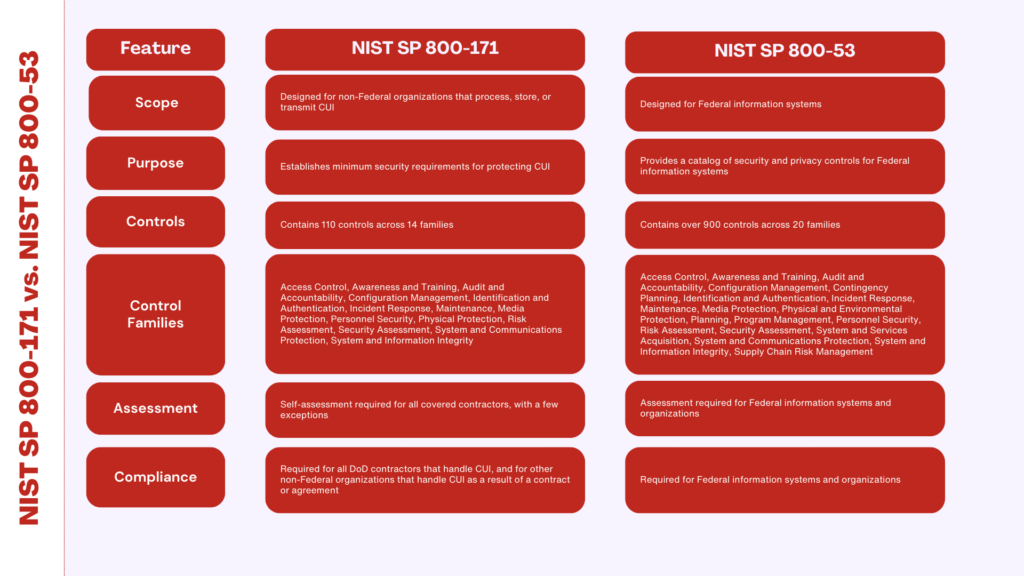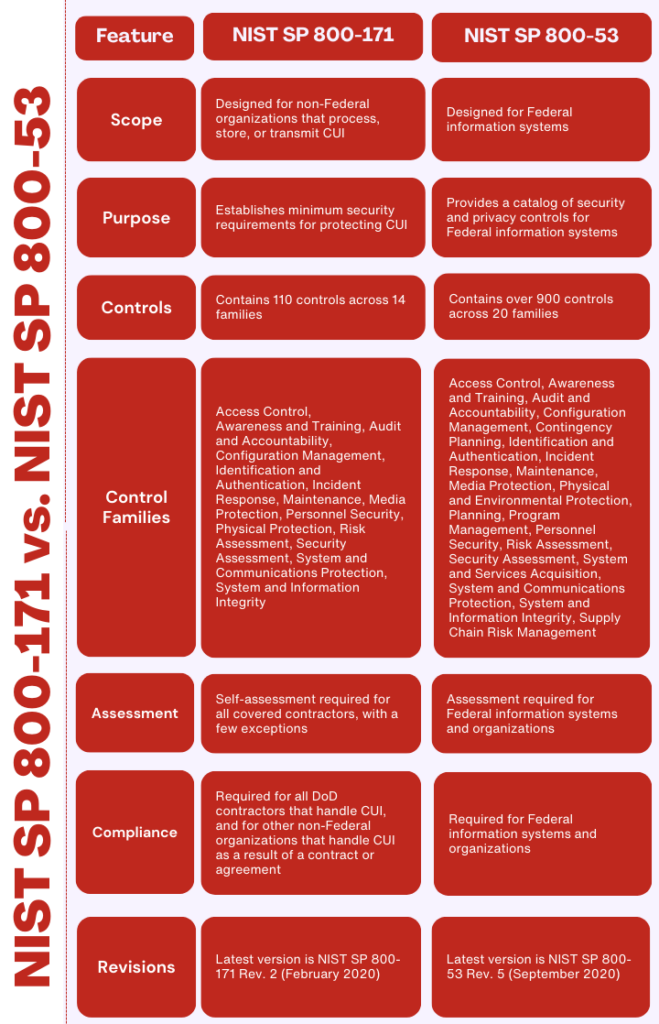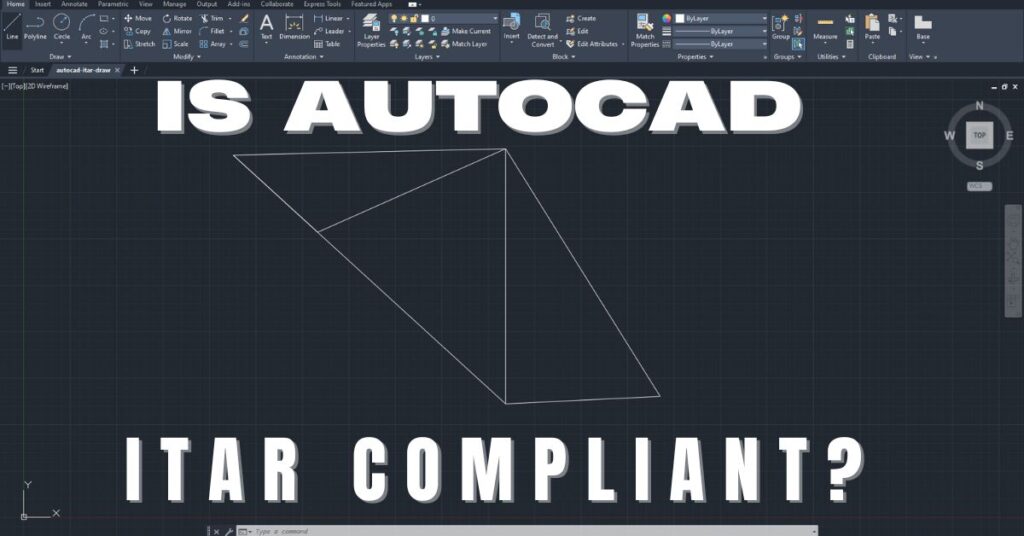Essential Differences: NIST SP 800-171 and NIST SP 800-53 Explained
NIST Special Publication (SP) 800-171 and NIST SP 800-53 are two important publications from the National Institute of Standards and Technology (NIST) that provide guidance on information security controls. Understanding the differences between the two publications is crucial for ensuring compliance with applicable regulations and best practices in information security. In this article, we will explore the details of each publication, their differences, and the compliance requirements.
NIST SP 800-171
NIST SP 800-171 is designed for non-Federal organizations that process, store, or transmit Controlled Unclassified Information (CUI). Its purpose is to establish minimum security requirements for protecting CUI, which is information that is not classified but still requires safeguarding or dissemination controls. Examples of CUI include financial information, export-controlled information, and certain types of personally identifiable information.
NIST SP 800-171 contains 110 controls across 14 families, covering areas such as access control, awareness and training, configuration management, and incident response. The publication provides guidance on how to assess and implement these controls to protect CUI.
One of the key features of NIST SP 800-171 is that it requires self-assessment by all covered contractors, with a few exceptions. Compliance with NIST SP 800-171 is required for all Department of Defense (DoD) contractors that handle CUI, and for other non-Federal organizations that handle CUI as a result of a contract or agreement. Failure to comply with NIST SP 800-171 can result in contract termination or suspension, among other penalties.
NIST SP 800-171 has been updated recently, with Revision 2 published in June 2020. The new revision includes several changes, such as adding new controls related to Supply Chain Risk Management and requiring Multi-Factor Authentication for privileged accounts.
NIST SP 800-53
NIST SP 800-53 is designed for Federal information systems. Its purpose is to provide a catalog of security and privacy controls for Federal information systems, covering areas such as access control, audit and accountability, contingency planning, and supply chain risk management. The controls are divided into 20 families, containing over 900 individual controls. NIST SP 800-53 is a comprehensive guide to information security controls that provides detailed guidance on how to select, implement, and assess controls.
Assessment is a key difference between NIST SP 800-171 and NIST SP 800-53. While self-assessment is required for compliance with NIST SP 800-171, assessment is required for Federal information systems and organizations to ensure compliance with NIST SP 800-53. The latest version of NIST SP 800-53 is Revision 5, which was released in September 2020 and reflects a more flexible and outcome-based approach to security and privacy control selection, assessment, and implementation.
NIST SP 800-53 is the basis for many Federal information security regulations and guidelines, such as the FISMA and the FedRAMP. Compliance with NIST SP 800-53 is required for all federal information systems, and non-federal organizations that handle federal information or provide services to federal agencies may also be required to comply.
Comparison
The differences between NIST SP 800-171 and NIST SP 800-53 can be summarized as follows:
- Scope: NIST SP 800-171 is focused on non-Federal organizations that handle CUI, while NIST SP 800-53 is focused on Federal information systems.
- Purpose: NIST SP 800-171 establishes minimum security requirements for protecting CUI, while NIST SP 800-53 provides a catalog of security and privacy controls for Federal information systems.
- Number of controls: NIST SP 800-171 has 110 controls across 14 families, while NIST SP 800-53 has over 900 controls across 20 families.
- Compliance requirements: NIST SP 800-171 requires self-assessment by covered contractors, while NIST SP 800-53 requires a comprehensive assessment of Federal information systems and organizations.
While both publications have their own specific requirements and purposes, they share some similarities. Both publications are based on the NIST Cybersecurity Framework and emphasize the importance of risk management, continuous monitoring, and incident response. They also provide guidance on how to implement and assess security controls effectively.
Compliance Requirements
Compliance with NIST SP 800-171 and NIST SP 800-53 is essential for organizations that handle CUI or Federal information systems. Failure to comply with these publications can result in penalties, loss of contracts, and reputational damage.
To ensure compliance with NIST SP 800-171, organizations must conduct a self-assessment of their security controls and provide a System Security Plan (SSP) and a Plan of Actions and Milestones (POA&M). The SSP provides an overview of the organization’s security posture, while the POA&M identifies any weaknesses or deficiencies and outlines a plan to address them.
To ensure compliance with NIST SP 800-53, Federal information systems and organizations must conduct a comprehensive assessment of their security controls using NIST SP 800-53A, which is a companion document to NIST SP 800-53. NIST SP 800-53A provides guidance on developing effective assessment plans, conducting assessments, and reporting assessment results. It includes a standardized assessment methodology and templates for conducting assessments, which can help ensure consistency and improve the quality of assessment results.


Conclusion
In conclusion, NIST SP 800-171 and NIST SP 800-53 are two important publications that provide guidance on information security controls. While they have different scopes, purposes, and numbers of controls, they both emphasize the importance of risk management, continuous monitoring, and incident response. Compliance with these publications is essential for organizations that handle CUI or Federal information systems, and failure to comply can result in penalties and reputational damage. Organizations must carefully review and comply with the specific requirements of these publications to ensure the protection of sensitive information and systems. If you have questions, give Cleared Systems a call.
Share in Social Media
See More Case Studies

Securing Defense Contracts: A DFARS 252.204-7012 Compliance Case Study
Discover how Cleared Systems helped a Federal Contractor successfully achieve DFARS 252.204-7012 compliance by strengthening its cybersecurity posture, giving it a competitive edge when bidding for DoD Contracts.

What is GCC High? For ITAR & CMMC 2.0
Microsoft 365 Government Community Cloud (GCC) High is a specialized cloud solution tailored for U.S. federal, state, local, tribal, and territorial government organizations, as well as for contractors who hold or process data subject to specific security regulations. In this article, we will explore the features, benefits, and differences between Microsoft 365 GCC High and other Office 365 offerings.

Is AutoCAD ITAR Compliant? A Comprehensive Guide for Defense Manufacturers
Defense contractors and manufacturers working with sensitive military technologies face a critical question when selecting computer-aided design software: Is AutoCAD ITAR compliant? This question becomes

How to Get Help in Windows: Guide to Security and Compliance Support
In today’s digital landscape, ensuring your computer systems are secure and compliant with industry regulations is essential for both businesses and individuals. Windows, as one

Microsoft Copilot for GCC High: Enhancing Security and Compliance
In today’s fast-evolving digital landscape, organizations that handle sensitive data, particularly those in government sectors or defense contractors, face growing pressure to maintain strict security
Partner with Us for Compliance & Protection
We’re happy to answer any questions you may have and help you determine which of our services best fit your needs.
Your benefits:
- Client-oriented
- Security
- Compliance
- Peace of mind
- Efficiency
- Trust
What happens next?
Schedule an initial meeting
Arrange a discovery and assessment call
Tailor a proposal and solution
